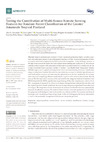Identificador persistente para citar o vincular este elemento:
https://accedacris.ulpgc.es/handle/10553/107285
| Campo DC | Valor | idioma |
|---|---|---|
| dc.contributor.author | Amoakoh, Alex O. | en_US |
| dc.contributor.author | Aplin, Paul | en_US |
| dc.contributor.author | Awuah, Kwame T. | en_US |
| dc.contributor.author | Delgado‐Fernandez, Irene | en_US |
| dc.contributor.author | Moses, Cherith | en_US |
| dc.contributor.author | Peña Alonso, Carolina Priscila | en_US |
| dc.contributor.author | Kankam, Stephen | en_US |
| dc.contributor.author | Mensah, Justice C. | en_US |
| dc.date.accessioned | 2021-05-24T18:04:12Z | - |
| dc.date.available | 2021-05-24T18:04:12Z | - |
| dc.date.issued | 2021 | en_US |
| dc.identifier.issn | 1424-8220 | en_US |
| dc.identifier.other | Scopus | - |
| dc.identifier.uri | https://accedacris.ulpgc.es/handle/10553/107285 | - |
| dc.description.abstract | Tropical peatlands such as Ghana’s Greater Amanzule peatland are highly valuable eco-systems and under great pressure from anthropogenic land use activities. Accurate measurement of their occurrence and extent is required to facilitate sustainable management. A key challenge, however, is the high cloud cover in the tropics that limits optical remote sensing data acquisition. In this work we combine optical imagery with radar and elevation data to optimise land cover classification for the Greater Amanzule tropical peatland. Sentinel‐2, Sentinel‐1 and Shuttle Radar Topography Mission (SRTM) imagery were acquired and integrated to drive a machine learning land cover classification using a random forest classifier. Recursive feature elimination was used to op-timize high‐dimensional and correlated feature space and determine the optimal features for the classification. Six datasets were compared, comprising different combinations of optical, radar and elevation features. Results showed that the best overall accuracy (OA) was found for the integrated Sentinel‐2, Sentinel‐1 and SRTM dataset (S2+S1+DEM), significantly outperforming all the other classifications with an OA of 94%. Assessment of the sensitivity of land cover classes to image features indicated that elevation and the original Sentinel‐1 bands contributed the most to separating tropical peatlands from other land cover types. The integration of more features and the removal of redundant features systematically increased classification accuracy. We estimate Ghana’s Greater Amanzule peatland covers 60,187 ha. Our proposed methodological framework contributes a robust workflow for accurate and detailed landscape‐scale monitoring of tropical peatlands, while our findings provide timely information critical for the sustainable management of the Greater Amanzule peatland. | en_US |
| dc.language | eng | en_US |
| dc.relation.ispartof | Sensors (Switzerland) | en_US |
| dc.source | Sensors [ISSN 1424-8220], v. 21 (10), 3399, (Mayo 2021) | en_US |
| dc.subject | 250501-1 Biogeografía botánica | en_US |
| dc.subject | 5102 Etnografía y etnología | en_US |
| dc.subject.other | Classification | en_US |
| dc.subject.other | Feature Selection | en_US |
| dc.subject.other | Google Earth Engine | en_US |
| dc.subject.other | Random Forest | en_US |
| dc.subject.other | Sentinel | en_US |
| dc.subject.other | Tropical Peatland | en_US |
| dc.title | Testing the contribution of multi‐source remote sensing features for random forest classification of the greater amanzule tropical peatland | en_US |
| dc.type | info:eu-repo/semantics/Article | en_US |
| dc.type | Article | en_US |
| dc.identifier.doi | 10.3390/s21103399 | en_US |
| dc.identifier.scopus | 85105741241 | - |
| dc.contributor.authorscopusid | 57223371564 | - |
| dc.contributor.authorscopusid | 6701865572 | - |
| dc.contributor.authorscopusid | 57204514082 | - |
| dc.contributor.authorscopusid | 32667474400 | - |
| dc.contributor.authorscopusid | 7004646988 | - |
| dc.contributor.authorscopusid | 57223362292 | - |
| dc.contributor.authorscopusid | 34868238600 | - |
| dc.contributor.authorscopusid | 57213457991 | - |
| dc.identifier.issue | 10 | - |
| dc.relation.volume | 21 | en_US |
| dc.investigacion | Artes y Humanidades | en_US |
| dc.type2 | Artículo | en_US |
| dc.description.notas | This article belongs to the Section Remote Sensors | en_US |
| dc.utils.revision | Sí | en_US |
| dc.date.coverdate | Mayo 2021 | en_US |
| dc.identifier.ulpgc | Sí | en_US |
| dc.contributor.buulpgc | BU-HUM | en_US |
| dc.description.sjr | 0,803 | |
| dc.description.jcr | 3,847 | |
| dc.description.sjrq | Q1 | |
| dc.description.jcrq | Q1 | |
| dc.description.scie | SCIE | |
| dc.description.miaricds | 10,8 | |
| item.fulltext | Con texto completo | - |
| item.grantfulltext | open | - |
| crisitem.author.dept | GIR IOCAG: Geografía, Medio Ambiente y Tecnologías de la Información Geográfica | - |
| crisitem.author.dept | IU de Oceanografía y Cambio Global | - |
| crisitem.author.dept | Departamento de Geografía | - |
| crisitem.author.orcid | 0000-0002-8589-0553 | - |
| crisitem.author.parentorg | IU de Oceanografía y Cambio Global | - |
| crisitem.author.fullName | Peña Alonso, Carolina Priscila | - |
| Colección: | Artículos | |
Citas SCOPUSTM
25
actualizado el 01-jun-2025
Citas de WEB OF SCIENCETM
Citations
20
actualizado el 01-jun-2025
Visitas
143
actualizado el 07-dic-2024
Descargas
83
actualizado el 07-dic-2024
Google ScholarTM
Verifica
Altmetric
Comparte
Exporta metadatos
Los elementos en ULPGC accedaCRIS están protegidos por derechos de autor con todos los derechos reservados, a menos que se indique lo contrario.
